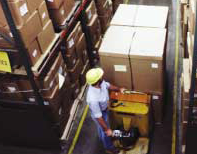Unsafe conditions lead to accidents. These conditions include anything in the work environment that may cause an accident because it is broken, defective, not up to standard, or inadequate. Fortunately, unsafe conditions can be corrected to prevent accidents.
Slippery Floors
Floors are slippery when wet. Mop up spills immediately. Dry off wet surfaces. When drying the floor is impractical – such as on rainy days when customers track in water on their shoes –place a caution sign warning against slippery surfaces. Do not leave liquid-filled containers, such as buckets or drinking cups, on the floor where they can be knocked over.
Obstacles
Employees carrying boxes or moving merchandise may be unable to see where they are stepping. To prevent trips and falls, clear pathways of rubbish bins, boxes and other obstacles. Check for loose carpets and floor tiles, too. If you spot these, contact a maintenance worker to fix the flooring. Never assume people will “watch where they’re going.”
Broken Equipment
Smoke detectors that do not work, exposed wiring and inadequate lighting in a stairwell are all examples of unsafe conditions. Such negligence can and should be corrected immediately. If you are aware of unsafe conditions, report them to a manager or supervisor. Regular maintenance should help keep problems in check. If unsafe conditions persist, you may have to contact an outside authority, such as the fire department, to force the retailer to fix the problem.
Blocked Exits
Warehouses are required by law to have a certain number of emergencies exists, depending on the size of the building. These emergency exits must be accessible at all times. They must also be clearly marked as an emergency exists. Regularly check all exits in the store or in your department. Do not block the exits with boxes or other obstacles. Clear pathways to emergency exits. Make sure that the doors are not chained or otherwise locked from the inside. And make sure that the exits are clearly marked. If electric exit signs are posted above the doors, make sure they are always lit.
Flammable Substances
Every worker must exercise caution in the presence of inflammable substances, heat sources and electrical sources. Fire can occur in any workplace, so all workers must be prepared to handle fire emergencies. They should always know where to locate and how to operate fire extinguishers. They must be familiar with evacuation plans in case of fire or explosion.
Electrical Equipment
Electrical equipment is used in most work environments. Warehouse jobs require workers to operate electric appliances, power tools or machines. Electricity can cause fires and electrocute workers. Avoid drinking liquids or stepping in water when using electrical equipment. Switch off machines before plugging and unplugging them. Do not use electrical equipment with electrical short or broken or frayed wires. Do not try to fix electrical equipment unless trained as an electrician.
Lifting Hazards/Physical Hazards
Many workers injure themselves because they do not lift objects properly. Nearly a fifth of all workplace injuries is due to overexertion in lifting. To lift heavy objects:
- Stand close to the object when lifting
- Bend the knew
- Keep the back straight
- Get a good hold of the object
- Keep the object close to the body as it is lifted
- Let the legs do the work
- Get help with very heavy objects
Solutions:Provide general ergonomics training and task-specific training. Minimize the need for lifting by using good design and engineering techniques. Lift properly and get a co-worker to help if a product is too heavy. |
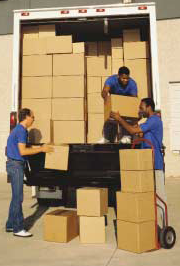 |
Dangerous Substances
Dangerous, toxic, flammable or explosive chemicals and substances make up the inventory of some warehouses. Employees must follow procedures to prevent leaks; fires and explosions where flammable materials are stored. Also, emergency procedures are usually established in case employees are exposed to dangerous chemicals. For instance, a worker who sprayed a toxic chemical should wash it immediately and thoroughly.
Chemical
Always wear the appropriate safety gear when working with these materials. Work in a well-ventilated area if fumes are a problem. Never leave caps off containers. Do not leave the containers where they can be knocked over or easily picked up. Make sure they are labelled clearly and correctly. Throw away empty boxes, old wrappings or other waste which could catch fire easily.
Solutions:Maintain a Material Safety Data Sheet (MSDS) for each chemical to which workers are exposed in the facility; Follow instructions on the MSDS for handling chemical products. Train employees on the risks of each chemical being stored. Provide spill cleanup kits in any area where chemicals are being stored. Have a written spill control plan. Train employees to clean up spills, protect themselves and properly dispose of used materials. Provide proper personal protective equipment and enforce its use. Store all chemicals safely and securely. Store chemicals away from forklift traffic areas. |
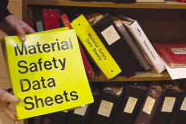 |
Fooling Around
Most employers discourage running and horseplay in the workplace, especially around dangerous substances and equipment. Workers should always move carefully and never hurry or become hysterical. Using alcohol, marijuana, or cocaine at work can be extremely dangerous and affects productivity. Jobs and drugs do not mix.
Handling of Stock, Inventory and Supplies
Warehouses and storerooms have formal procedures or unwritten rules governing how supplies should be arranged. For instance, heavier supplies are usually placed on the bottom shelves while lighter ones are placed on top. If the shelving units in storage rooms are above the head, ladders are provided so employees will not stretch and hurt their backs when loading and unloading supplies. Supplies should be placed in their proper locations immediately upon delivery and not left blocking passageways and entrances.
Make sure shelves are sturdy and safe. Check those fixtures are firmly attached and supported. They should not wobble or fall over if brushed or bumped against. The tables, stands, counters, shelves or cases supporting them must likewise be sturdy and secure. Unsecured shelves can injure staff if they fall over. At the very least, they can damage the merchandise.
Solutions:
- Stack loads evenly and straight
- Place heavier loads on lower or middle shelves
- Remove one object at a time from shelves
- Keep aisles and passageways clear and in good repair
Sloppy Areas
A cluttered, sloppy, or dirty workplace increased the chance that someone may have an accident. Many employers establish strict maintenance guidelines. For instance, packing boxes must be disposed of immediately after they have been unpacked. Liquids spilt on the floor should be cleaned up immediately and a sign placed indicating the floor is wet.
Docks
Injuries happen here when forklifts run off the dock, products fall on employees or equipment strikes a person.
Solutions:Drive forklifts slowly on docks and docks plates. Secure dock plates and check to see if the plate can safely support the load. Keep clear of dock edges and never back up forklifts to the dock’s edge. Provide visual warnings near dock edges. Prohibit “dock jumping” by employees. Make sure that dock ladders and stairs meet OSHA specifications. |
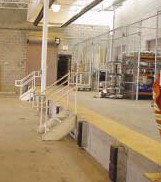 |
Forklifts
Many employees are killed and injured every year while operating forklifts in warehouses. Forklift turnovers account for a significant percentage of these fatalities.
Solutions:Train, evaluate and certify all operators to ensure that they can operate forklifts safely. Do not allow anyone under 18 years old to operate a forklift. Properly maintain haulage equipment, including tires. Before using a forklift, examine it for hazardous conditions which would make it unsafe to operate. Follow safe procedures for picking up, putting down and stacking loads. Drive safely, never exceeding 10km ph and slow down in congested areas or those with slippery surfaces. Ensure that the operator wears a seatbelt installed by the manufacturer. Never drive up to a person standing in front of a fixed object such as a wall or stacked materials. Prohibit stunt driving and horseplay. Do not handle loads that are heavier than the weight capacity of the forklift. Remove unsafe or defective trucks from service until the defect is properly repaired. Maintain sufficiently safe clearances for aisles and at loading docks or passages where forklifts are used. Ensure adequate ventilation either by opening doors/windows or using a ventilation system to provide enough fresh air to keep concentrations of noxious gases from engine exhaust below acceptable limits. Provide covers and/or guardrails to protect workers from the hazards of open pits, tanks, vats and ditches. Train employees on the hazards associated with the combustion byproducts of forklift operation, such as carbon monoxide. |
|
Conveyors
Workers can be injured when they are caught in pinch points or in the in-going nip points, are hit by falling products or develop musculoskeletal disorders associated with awkward postures or repetitive motions.
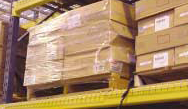 |
Solutions:Inspect conveyors regularly. Ensure that pinch points are adequately guarded. Develop ways of locking out conveyors and train employees in these procedures. Provide proper lighting and working surfaces in the area surrounding the conveyor. |
Charging Stations
Fires and explosion risks are possible unless proper guidelines are followed.
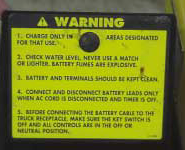 |
Solutions:Prohibit smoking and open flames in and around charging stations. Provide adequate ventilation to disperse fumes from gassing batteries. Ensure that fire extinguisher are available and fully charged. Provide proper personal protective equipment such as rubber gloves and eye and face protection. Properly position forklifts and apply brakes before attempting to change or charge batteries; follow required procedures when refuelling gas or propane-fueled forklifts. Provide conveyors, overhead hoists or equivalent materials handling equipment for servicing batteries. Provide an eye washing and safe shower facility for employees exposed to battery acids. |
Poor Ergonomics
Improper lifting, repetitive motion or poor design of operations can lead to musculoskeletal disorders in workers.
Solutions:If possible, use powered equipment instead of requiring a manual lift for heavy materials. Reduce lifts from shoulder height and from floor height by repositioning the shelf or bin. Ensure overhead lighting is adequate for the task at hand. Provide employees with task-oriented ergonomic training. Use your legs and keep your back in a natural position while lifting. Test the load to be lifted to estimate its weight, size and bulk, and to determine the proper lifting method. Get help if the load exceeds the maximum weight a person can lift safely without assistance. Don’t twist while carrying a load, but shift your feet and take small steps in the direction you want to turn. Keep floors clean and free of slip and trip hazards. |
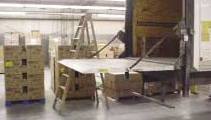 |

